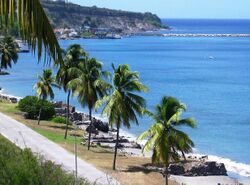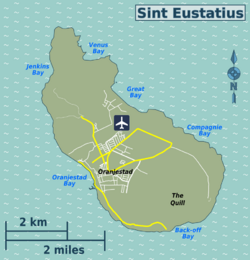Oranjestad, Sint Eustatius
Topic: Place
 From HandWiki - Reading time: 3 min
From HandWiki - Reading time: 3 min
Oranjestad | |
|---|---|
Town | |
 Beach of Lower Town. | |
 Location on the island of Sint Eustatius | |
| Coordinates: [ ⚑ ] : 17°29′N 62°59′W / 17.483°N 62.983°W | |
| Country | Netherlands |
| Public body | Sint Eustatius |
| Population (2001)[1] | |
| • Total | 1,038 |
| Time zone | UTC-4 (AST) |
| Climate | Aw |
Oranjestad (Dutch pronunciation: [oːˈrɑɲəstɑt]; English: Orange[4] Town) is a small town of 1,038 inhabitants;[1] it is the capital and largest town of the island of Sint Eustatius in the Caribbean Netherlands. It’s not to be confused with the far larger Oranjestad in Aruba.
Geography
Oranjestad is a historic harbour town which is divided into two main sections. Lower Town is a strip of buildings just above sea level along the waterfront, which borders on the island's safest beach. Lower Town includes dive shops, numerous colonial-era ruins, and the harbour. Upper Town has a restored historic core, and is also the island's main commercial and residential centre.
History
Historical sites
The first colonist arrived between 1625 and 1629.[5] Sint Eustatius produced sugar and cotton, but most importantly developed into a centre of the North American slave trade.[6] In 1780, the island had an estimated population of 20,000 people including slaves. In 1781, during the Fourth Anglo-Dutch War, the island was captured and plundered by George Rodney.[5] During the capture, all archives were destroyed.[7] In 1786, it was home to 7,600 people (3,000 white, 600 coloureds and 4,000 slaves). In 1829, the population had decreased to 2,273.[5]
The main historical site in Oranjestad is Fort Oranje, a well-maintained, 17th-century fort in the direct centre of the town, overlooking the waterfront. This cliff-side fort has cannons, intact bastions and a courtyard. Nearby is a museum, the ruins of one of the oldest synagogues in the Western Hemisphere, and a Jewish cemetery.[8]
The town's historical features also include a Dutch Reformed church built in 1755,[8] which is partly in ruins but still accessible (its tower can be climbed for long-distance views), various restored 18th-century merchants' residences – including the oldest one, the Gezaghebber House (former Lieutenant Governor's residence) on Kerkstraat – and restored wooden Caribbean-style houses. Snorkeling in Oranje Bay is also interesting because of the parts of 18th century buildings on the bay side that were swept into the sea.[9]
Facilities
Oranjestad itself contains grocery stores, restaurants, bars, a library, schools, a clinic and the administrative offices of the government. [citation needed]
Climate
Script error: No such module "weather box".
See also
- List of lighthouses in Sint Eustatius
- F. D. Roosevelt Airport
- St. Eustatius Church
References
- ↑ 1.0 1.1 "Geodata 2001, Saba & Sint.Eustatius, Census 2001". 2001. http://digitallibrary.cbs.cw/CBS0000228/00001. "Sum of Oranjestad Noord, Oranjestad Zuid, Concordia and Golden Rock"
- ↑ Rowlett, Russ. "Lighthouses of Saba and Sint Eustatius". The Lighthouse Directory. University of North Carolina at Chapel Hill. http://www.ibiblio.org/lighthouse/sab.htm.
- ↑ Template:Cite ngall
- ↑ The House of Orange-Nassau — Dutch: Het Huis Oranje-Nassau — read Prince of Orange (Dutch: Prins van Oranje) and related articles for more.
- ↑ 5.0 5.1 5.2 Benjamins & Snelleman 1917, p. 627.
- ↑ Benjamins & Snelleman 1917, p. 629.
- ↑ Benjamins & Snelleman 1917, p. 93.
- ↑ 8.0 8.1 "Sint-Eustatius en alles wat reizen boeiend maakt." (in nl). https://groenroodwit.nl/2020/10/sint-eustatius-fort-oranje-de-plek-waar-alles-samenkomt/.
- ↑ Peter van Dun; Ben de Vries (2002). "Monumenten Boven de Wind" (in nl). Jaarboek Monumentenzorg: 139–140. https://dbnl.nl/tekst/_jaa030200201_01/_jaa030200201_01_0021.php?q=Oranjestad%20eustatius#hl1.
- ↑ "SUMMARY OF CLIMATOLOGICAL DATA, PERIOD 1971 - 2000". Meteo Curacao. https://www.meteo.cw/Data_www/Climate/documents/CLIM_SUM_Eus.pdf.
Bibliography
- Benjamins, Herman Daniël; Snelleman, Johannes (1917) (in nl). Encyclopaedie van Nederlandsch West-Indië. Leiden: Martinus Nijhoff Publishers. https://www.dbnl.org/tekst/benj004ency01_01/.
External links
 |
 KSF
KSF

